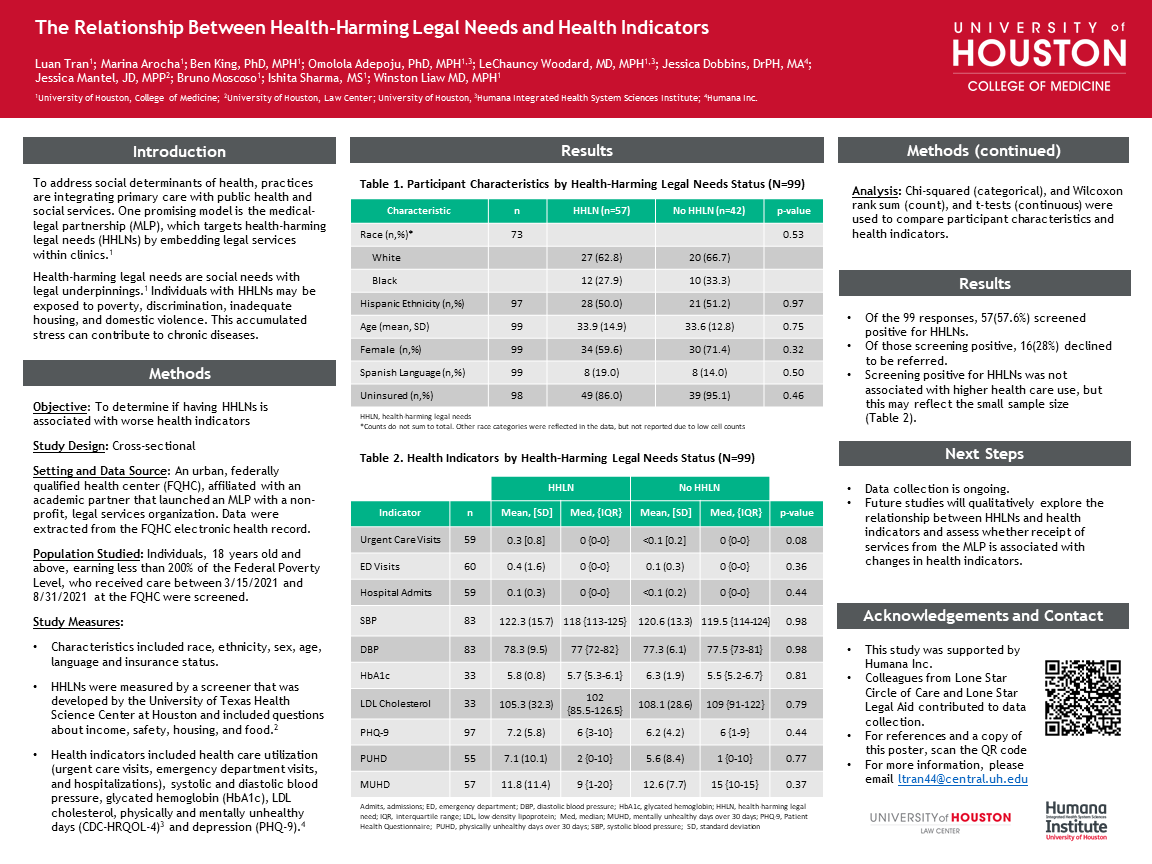PRP090: The Relationship Between Health-Harming Legal Needs and Blood Pressure
Winston Liaw, MD, MPH; Luan Tran, BS; Marina Arocha, BS; Jessica Mantel, JD, MPP
Abstract
Context: To address social determinants of health, practices are integrating primary care with public health and social services. One promising model is the medical-legal partnership (MLP), which targets health-harming legal needs (HHLNs) by embedding legal services within clinics. Individuals with HHLNs often live in poverty and face discrimination at work, inadequate housing, and domestic violence. This accumulated stress has the potential to contribute to chronic diseases, including hypertension.
Objective: To determine if having HHLNs is associated with higher blood pressure
Study Design: Cross-sectional
Setting or Data Set: An urban, federally qualified health center, affiliated with an academic partner that recently launched an MLP with a non-profit, legal services organization
Population Studied: Individuals, 18 years old and above, earning less than 200% of the Federal Poverty Level, who received care at the clinic
Intervention/Instrument: Given the lack of a gold-standard screening tool for HHLNs, we collaborated with legal experts to develop a new instrument. All patients who meet the inclusion criteria are offered screening. Their responses are categorized into three groups: 1) those who screen positive and agree to the MLP referral, 2) screen positive and decline the referral, and 3) screen negative.
Outcome Measures: Blood pressure will be categorized into four groups: 1) systolic < 120 mmHg and diastolic < 80 mmHg, 2) systolic 120-129 mmHg and diastolic < 80 mmHg, 3) systolic 130 -139 mmHg or diastolic 80-89 mmHg, and 4) systolic at least 140 mmHg or diastolic at least 90 mmHg. Patient characteristics include gender, age, race, ethnicity, language, insurance, and legal needs. These values will be obtained on the date of screening and from the clinic’s electronic health record. The association between HHLNs and blood pressure will be assessed using chi-squared tests. The relationship between blood pressure and multiple independent variables (patient characteristics and the HHLN-screening results) will be tested using ordinal regression.
Results: We hypothesize that those who screen positive and agree to the MLP referral will have the highest percentage of individuals in the highest blood pressure category.
Outcomes to be Reported: We will report descriptive characteristics, blood pressure category percentages by screening group, and regression model results.
Objective: To determine if having HHLNs is associated with higher blood pressure
Study Design: Cross-sectional
Setting or Data Set: An urban, federally qualified health center, affiliated with an academic partner that recently launched an MLP with a non-profit, legal services organization
Population Studied: Individuals, 18 years old and above, earning less than 200% of the Federal Poverty Level, who received care at the clinic
Intervention/Instrument: Given the lack of a gold-standard screening tool for HHLNs, we collaborated with legal experts to develop a new instrument. All patients who meet the inclusion criteria are offered screening. Their responses are categorized into three groups: 1) those who screen positive and agree to the MLP referral, 2) screen positive and decline the referral, and 3) screen negative.
Outcome Measures: Blood pressure will be categorized into four groups: 1) systolic < 120 mmHg and diastolic < 80 mmHg, 2) systolic 120-129 mmHg and diastolic < 80 mmHg, 3) systolic 130 -139 mmHg or diastolic 80-89 mmHg, and 4) systolic at least 140 mmHg or diastolic at least 90 mmHg. Patient characteristics include gender, age, race, ethnicity, language, insurance, and legal needs. These values will be obtained on the date of screening and from the clinic’s electronic health record. The association between HHLNs and blood pressure will be assessed using chi-squared tests. The relationship between blood pressure and multiple independent variables (patient characteristics and the HHLN-screening results) will be tested using ordinal regression.
Results: We hypothesize that those who screen positive and agree to the MLP referral will have the highest percentage of individuals in the highest blood pressure category.
Outcomes to be Reported: We will report descriptive characteristics, blood pressure category percentages by screening group, and regression model results.

Diane Harper
harperdi@med.umich.edu 11/21/2021thank you for sharing this with NAPCRG! The intersection of the legal system and health care has been known - your team adds a new prognostic dimension to the process. Keep up the great work!